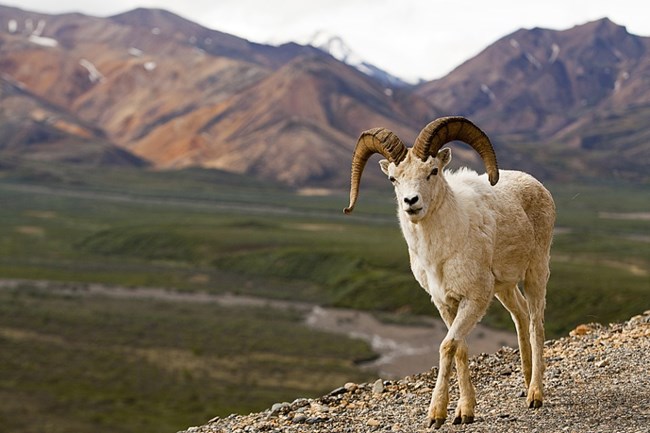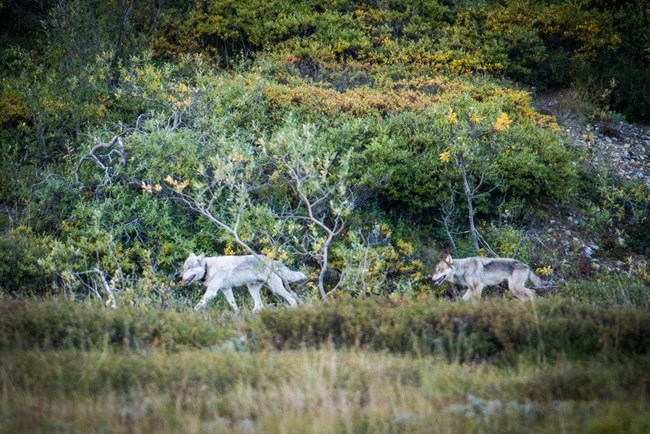You made it to Camp 2! Phew! Find this camp on your mountain and complete your next three activities.
NPS Photo / Nathan Kostegian Wildlife of DenaliDenali was the first national park established mainly to protect wildlife. A hunter and naturalist named Charles Sheldon observed how overhunting harmed the local population of Dall sheep. He fought for laws to protect the area starting in 1906 and celebrated Denali finally becoming a national park in 1917. 1) What is one wild animal that would inspire you to protect a place as a national park? Write or draw your answer next to Camp 2 on your mountain.What can we learn from wildlife?Denali is famous for its "Big Five" largest animals: Dall sheep, grizzly bears, wolves, moose, and caribou. Smaller animals like arctic ground squirrels, snowshoe hares, ptarmigan, and wood frogs play equally important roles in the Denali ecosystem. Wildlife biologists are scientists who study animals and their behavior in nature. Read, look, and listen below to discover what we can learn from Denali's wildlife. 
Left: NPS Photo; Right: Photo courtesy of Alaska Department of Fish and Game Like Charles Sheldon, wildlife biologists at Denali continue to study and learn from Dall sheep in their natural habitat. From close inspection of Dall sheep horns, we can learn their age, similar to tree rings! Darker growth rings represent each year of life. Count the number of growth rings on the horn pictured to estimate the age of a Dall sheep. Scientists at Denali also record natural sounds and measure impacts of human noises throughout the park. Recording the sounds of wildlife can teach us how animals communicate. Click below to hear the sounds of a Dall sheep ram.

NPS Photo / Kent Miller To study wolves at Denali, wolf biologists fit sedated wolves with radio collars that emit signals from far away. One or two wolves in every pack wear radio collars that help biologists monitor the movement of the pack. We learned that 10-12 different wolf packs travel in and around Denali. Which of the two wolves pictured is wearing a radio collar? Scientists record Denali wolf packs howling to rally together, start a hunt, or claim territory, like cheering at a sports game. Click below to hear the sounds of a howling wolf pack.

Left: NPS Photo / Kent Miller; Bottom Right: NPS Photo Wildlife biologists at Denali study bears by analyzing their scat. Scat is the scientific word for animal poop. We can learn a lot about the species of bears in the park (and their diets) from what they leave behind. One study even recruited visitors to help collect bear scat! By collecting scat for science, visitors connected with the wildlife of Denali while keeping humans and bears safe from each other. Scientists record curious bears and playful cubs, too. Click below to hear the sounds of a mother bear with her two cubs. 2) If you could record one wild animal sound, what would that sound be? What do you think that sound means? Write your answer next to Camp 2.
How can we keep wildlife wild?Denali provides a vast laboratory for scientists to study animals in their natural habitat, where they roam wild without human interference. Rangers at Denali teach visitors to quietly observe wildlife from a safe distance and keep human food packed away. This prevents wildlife from relying on humans as an unnatural food source. Visitors are lucky to observe wolves stalking caribou or bears munching berries – not stealing lunches from picnic tables! If we can learn so much from Denali's wildlife, what might you discover about animals in your area? 3) Quietly observe a wild animal outside. Bugs and birds count! What is the animal doing? Why do you think it might be doing that? Write your answer next to Camp 2.
NPS Photo Learn More, Climb Higher(Optional) To take a detour and learn more about the wildlife and sounds of Denali, please visit: Ready to climb onward? Click on Camp 3 using the interactive mountain map! ⇒ |
Last updated: February 4, 2025
